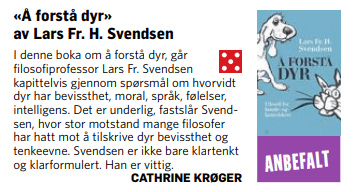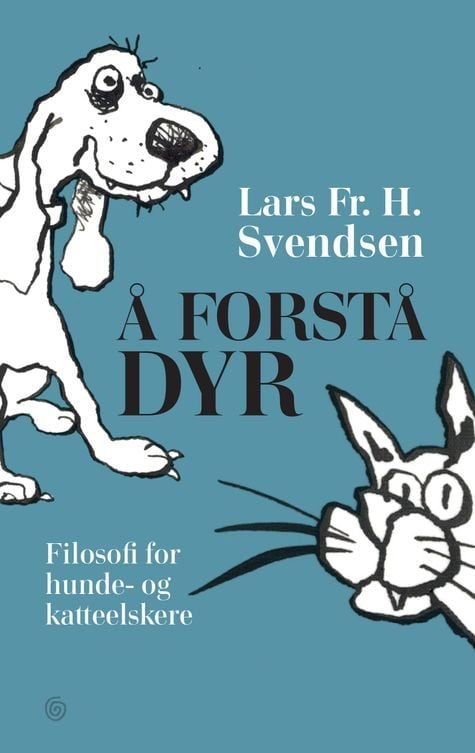Lars Fredrik Svendsen philosophises on animals with humour, compassion and playful reflection.
While I am sitting having breakfast and one of our two cats comes sauntering by it is quite easy to understand what it wants. Either food or to go out. If it wants the latter, it looks in the direction of the door. If it is hungry then it makes a purring sound or meows and turns in the direction of its food dish. You don’t have to practice witchcraft to understand animals, at least those we live close to.
“Yet for centuries philosophers and scientists have insisted on the strangest notions about animals” philosopher Lars Fredrik Svendsen tells us in “Understanding Animals” – a book which can be regarded as the first philosophical work on animals in Norwegian.
Biological Machine. Presumedly the strangest notion is philosopher René Decartes’ assertion that animals are biological machines and cannot feel pain. If we see pain-like behaviour in an animal, we should just ignore it, he believed, for there is no more suffering in an animal then there is in pistons and propellers.
No matter how seduced Decartes was by this mechanical concept it is difficult to understand how he could possibly think of animals in this manner. This point of view has contributed to actual suffering in animals when people inspired by this belief – and without taking into consideration what the animals are experiencing – have ignored what they have tried to tell us.
Philosopher Lars Fredrik Svendsen takes a basic, empathic and pragmatic approach in his observations of animals. And wisely so.
The soul’s visibility. The fact that philosophers have doubted that animals have awareness is fundamentally quite absurd, because awareness is not something we can observe in any one particular place. Not even in humans. When we see another person suffering, we do not need to make a long drawn out reasoning to understand that this person is not having an enjoyable experience. Pain is inherently behaviour. Likewise, we hardly require derivations of painful behaviour to understand when someone is suffering that yes, they are quite aware of it. Behaviour is awareness. “Feeling is not behind a gesture but is its content.” Svendsen writes. In both humans and animals.
Animal Intelligence. There is no doubt that animals have both intelligence and the ability to communicate with one another and with us. However animals do not possess a reflective consciousness, that is to say aware of extensive projects which lie in the future. Svendsen provides many interesting links to philosophy here, among them to the German philosopher Martin Heidegger.
“Heidegger asserts that a dog can smell a leaf that lies on the ground, but does not experience the leaf as a leaf which has fallen from a tree nor the very fact that it has fallen from a tree denotes the season is about to change. The dog lives – as do other animals – in the immediate world.
Pencil as a stick. The chapter on the biologist Jakob von Uexküll is one of the book’s most interesting sections, for here Svendsen approaches the animal’s own reality though the concept of “world”. According to Uexküll, each animal has its own world which is defined by what is meaningful to that particular animal, which then becomes the world’s subject. For a dog a pencil would be a stick or something to chew on, Svendsen writes. It would be mistaken to conclude that a dog doesn’t understand the concept of pencil, because writing is not a part of the dog’s world. A simple but significant observation.
Little examples from art. However there are some areas where I believe the book falls short. I would like to have seen Svendsen treat to a larger degree a better understanding animals through art and literature – of which there are a great many examples. Art has much to offer when immersing oneself deeper into the animal’s world, something which could lead to new perspectives in animal philosophy.
There are many charming examples from the writer’s own experience, but could to his advantage, have exchanged these examples from his own household with works of literature or art history. In that way the book would have achieved a greater richness of variation and a several insights into the animal soul which neither philosophy nor science can offer.
Being Animal. Several other philosophers could also have be included. Gilles Deleuze and Feliz Guattaris´ thoughts on “being an animal” comes to mind, not to mention their analysis of Gregor Samsa’s transformation into a giant insect (literally “monstrous vermin”) in Franz Kafka’s “Metamorphosis”. This omission is notable since Svendsen has included a special section on how we can approach the animal perspective by mimicking or acting as they do.
Other feelings which animals possess could have been treated rather than those Svendsen describes, and which Friedrich Nietzsche writes about in Untimely Meditations, that humans envy cows because they live in the moment and are not weighed down by the past, as we are when we remember. But this is nit-picking.
Svendsen is routined at writing in an accessible manner, and here he has written something everyone can read, requiring little or a minimum of special knowledge. That is an impressive feat itself.
Another plus with the book – which is surprisingly very much present – is the amount of humour Svendsen offers this time. I found myself laughing long and often, not because the writer comes with an occasional joke, but because of his understated, dry humorous formulations.
For example, his rejection of our close relationship with apes: “We can just a little conclude that a person is “half banana because 50% of his DNA is the same as a banana, as we can conclude that a person is 98.5 percent chimpanzee”.
“Understanding Animals” is the kind of book I’ve been wanting to read for a long time, but didn’t realise the fact until I got the book in my hands. I like both cats and philosophy – so this is pleasure reading de luxe.
Reviewed by Kjetil Røed (Vårt Land)


